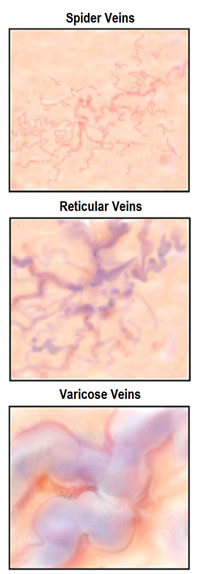Reticular Veins and Treatments

Reticular veins are also known as feeder veins. They are larger than spider veins but smaller than varicose veins. Treating reticular veins can be important because these are often the veins feeding those annoying networks of smaller spider veins. Many patients come to the office with a history of multiple unsuccessful treatments for spider veins. With the presence of these veins, it is difficult to treat the smaller spider veins until the reticular networks are treated first. The spider veins continue to open up after treatments because these networks continue to “feed” veins to the smaller spider veins.
Symptoms
Reticular veins are about 2-3 mm in diameter. They typically present on the inner thighs or the ankles. They can also form on the back of the legs. Unlike varicose veins, reticular veins don’t necessarily protrude above the surface of the skin but they can still be painful or uncomfortable. The veins are usually blue-green or purple and can form areas of unattractive clusters.
Causes and Risk Factors
Like most vein disease, reticular veins can be caused by failed vein valves known as venous insufficiency. Unfortunately, this condition does not improve without treatment. Sometimes reticular veins may not be caused by vein disease. In these cases some risk factors that are associated with reticular veins are heredity, standing for long periods of time, injury, and obesity.
Diagnosis
Most reticular veins can be diagnosed by the patient. However, like most other vein conditions, these veins typically exist for a reason. Sometimes there is underlying venous insufficiency which causes them to occur. Therefore, it is important to determine if venous insufficiency exists and treat it first. If you are suffering from reticular veins, Dr. Aquino will order a venous ultrasound to determine if the cause is venous insufficiency.
Reticular veins treatment
Reticular veins are typically treated the same way as spider veins using sclerotherapy injections. This is a simple procedure performed in the office. A special solution is injected in to the veins which causes them to become irritated and then close. The procedure is not considered painful and takes 30 minutes per session. During the session, as many veins are treated as possible. Patients typically wait about a month to see the results. They return for sequential treatments if more is needed. How many sessions are needed depends on how well the patient responds to the injections and how many retuiclar veins they have.
